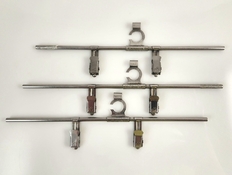L Gebhardt
Member
I also used SLIMT for the first time on a print of the same negative as above. This is one I could not print to my satisfaction in the darkroom using low contrast filtration. I do have a very nice inkjet print on the wall, but it bothers me that I gave up on the darkroom print. I've decided to use it as a way to expand my knowledge of masking and printing. SLIMT was something I've wanted to experiment with for a while, despite all the negative comments I keep coming across.
My results were highly positive and encouraging. I simply found the correct exposure that still showed some of the waves in the main sun reflection printed at grade 2. That gave print with a lot of contrast but showed the play of light on the water as I wanted it. My first SLIMT print was at 4ml/400ml for 2 minutes, as recommended, and developed normally. That was unbelievably low contrast but still contained most of the detail in the brightest part of the water. Next I went to 1ml/400m for 2 minutes and developed normally. That resulted in a very convincing straight print with just about the right contrast and exposure. I did a few more variations but that second print is my favorite.
Thank you David Kachel for working out the details and publicizing your methods, as well as Christopher Layne for starting this thread which got me to try SLIMT.
My results were highly positive and encouraging. I simply found the correct exposure that still showed some of the waves in the main sun reflection printed at grade 2. That gave print with a lot of contrast but showed the play of light on the water as I wanted it. My first SLIMT print was at 4ml/400ml for 2 minutes, as recommended, and developed normally. That was unbelievably low contrast but still contained most of the detail in the brightest part of the water. Next I went to 1ml/400m for 2 minutes and developed normally. That resulted in a very convincing straight print with just about the right contrast and exposure. I did a few more variations but that second print is my favorite.
Thank you David Kachel for working out the details and publicizing your methods, as well as Christopher Layne for starting this thread which got me to try SLIMT.










